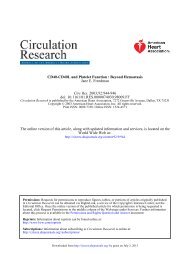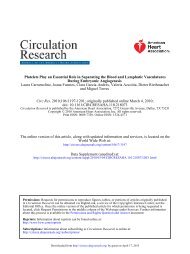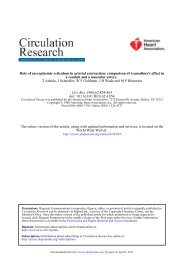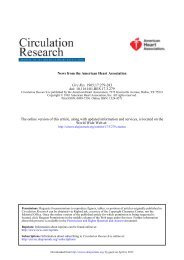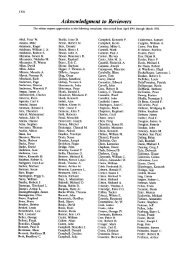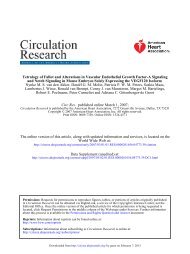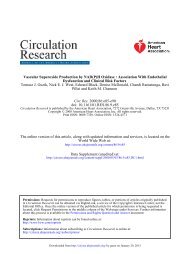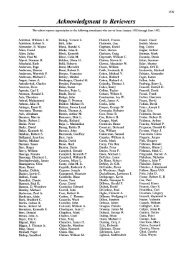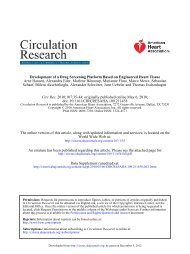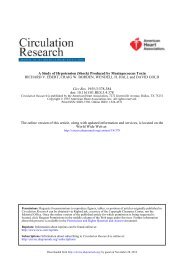Pitfalls in Digital Computation of the Impulse Response of Vascular ...
Pitfalls in Digital Computation of the Impulse Response of Vascular ...
Pitfalls in Digital Computation of the Impulse Response of Vascular ...
You also want an ePaper? Increase the reach of your titles
YUMPU automatically turns print PDFs into web optimized ePapers that Google loves.
<strong>Pitfalls</strong> <strong>in</strong> <strong>Digital</strong> <strong>Computation</strong> <strong>of</strong> <strong>the</strong> <strong>Impulse</strong> <strong>Response</strong> <strong>of</strong> <strong>Vascular</strong> Beds from<br />
Indicator-Dilution Curves<br />
JOHN GAMEL, WILLIAM F. ROUSSEAU, CHARLES R. KATHOLI and EMMANUEL<br />
MESEL<br />
Circ Res. 1973;32:516-523<br />
doi: 10.1161/01.RES.32.4.516<br />
Circulation Research is published by <strong>the</strong> American Heart Association, 7272 Greenville Avenue, Dallas, TX 75231<br />
Copyright © 1973 American Heart Association, Inc. All rights reserved.<br />
Pr<strong>in</strong>t ISSN: 0009-7330. Onl<strong>in</strong>e ISSN: 1524-4571<br />
The onl<strong>in</strong>e version <strong>of</strong> this article, along with updated <strong>in</strong>formation and services, is located on <strong>the</strong><br />
World Wide Web at:<br />
http://circres.ahajournals.org/content/32/4/516<br />
Permissions: Requests for permissions to reproduce figures, tables, or portions <strong>of</strong> articles orig<strong>in</strong>ally published <strong>in</strong><br />
Circulation Research can be obta<strong>in</strong>ed via RightsL<strong>in</strong>k, a service <strong>of</strong> <strong>the</strong> Copyright Clearance Center, not <strong>the</strong><br />
Editorial Office. Once <strong>the</strong> onl<strong>in</strong>e version <strong>of</strong> <strong>the</strong> published article for which permission is be<strong>in</strong>g requested is<br />
located, click Request Permissions <strong>in</strong> <strong>the</strong> middle column <strong>of</strong> <strong>the</strong> Web page under Services. Fur<strong>the</strong>r <strong>in</strong>formation<br />
about this process is available <strong>in</strong> <strong>the</strong> Permissions and Rights Question and Answer document.<br />
Repr<strong>in</strong>ts: Information about repr<strong>in</strong>ts can be found onl<strong>in</strong>e at:<br />
http://www.lww.com/repr<strong>in</strong>ts<br />
Subscriptions: Information about subscrib<strong>in</strong>g to Circulation Research is onl<strong>in</strong>e at:<br />
http://circres.ahajournals.org//subscriptions/<br />
Downloaded from<br />
http://circres.ahajournals.org/ by guest on December 6, 2012
<strong>Pitfalls</strong> <strong>in</strong> <strong>Digital</strong> <strong>Computation</strong> <strong>of</strong> <strong>the</strong> <strong>Impulse</strong> <strong>Response</strong><br />
<strong>of</strong> <strong>Vascular</strong> Beds from Indicator-Dilution Curves<br />
By John Gamel, William F. Rousseau, Charles R. Katholi, and Emmanuel Mesel<br />
ABSTRACT<br />
Many methods are available for digital computation <strong>of</strong> <strong>the</strong> impulse response from<br />
<strong>in</strong>dicator-dilution measurements represent<strong>in</strong>g <strong>in</strong>put and output signals. In all <strong>in</strong>stances,<br />
<strong>the</strong> only criterion for validity <strong>of</strong> <strong>the</strong> computation is comparison <strong>of</strong> <strong>the</strong> reconvolution <strong>of</strong><br />
<strong>the</strong> computed impulse response and <strong>the</strong> <strong>in</strong>put with <strong>the</strong> actual output. In this paper, a<br />
model ma<strong>the</strong>matical system was constructed with a known impulse response; noise and<br />
time variation could be <strong>in</strong>troduced <strong>in</strong>dependently or simultaneously <strong>in</strong> <strong>the</strong> <strong>in</strong>put and<br />
<strong>the</strong> output data. Six methods for digital computation <strong>of</strong> <strong>the</strong> impulse response were<br />
applied to data from this system and to actual dye-dilution data. Precision <strong>of</strong> reconvolution<br />
did not assure that <strong>the</strong> computed response would resemble <strong>the</strong> actual response <strong>of</strong><br />
<strong>the</strong> system. Some numerical considerations also significantly affected <strong>the</strong> digital computation<br />
<strong>of</strong> a valid response.<br />
KEY WORDS<br />
reconvolution<br />
transfer function<br />
ma<strong>the</strong>matical models<br />
• Zierler (1) orig<strong>in</strong>ally described <strong>the</strong> significance<br />
<strong>of</strong> <strong>the</strong> impulse response <strong>of</strong> vascular beds and its<br />
relationship to <strong>in</strong>dicator-dilution measurements,<br />
and this function has s<strong>in</strong>ce been used for a variety<br />
<strong>of</strong> purposes. Scheel et al. (2) used a relationship<br />
identical to that <strong>in</strong> Eq. 1 (see below) to correct for<br />
ca<strong>the</strong>ter distortion <strong>of</strong> sampled dye concentrations.<br />
Coulam et al. -(3) exam<strong>in</strong>ed changes <strong>in</strong> <strong>the</strong> impulse<br />
response <strong>of</strong> various <strong>in</strong> vivo vascular beds result<strong>in</strong>g<br />
from <strong>in</strong>jections <strong>of</strong> angiotens<strong>in</strong>, acetylchol<strong>in</strong>e, and<br />
adenos<strong>in</strong>e triphosphate. Lange et al. (4) exam<strong>in</strong>ed<br />
<strong>the</strong> relationship between <strong>the</strong> arterial circulatory<br />
transfer function and respiratory control. Moreover,<br />
Bass<strong>in</strong>gthwaighte et al. (5), Knoop et al. (6), and<br />
Greenleaf et al. (7) have attempted to use <strong>the</strong><br />
nature <strong>of</strong> <strong>the</strong> calculated impulse response to draw<br />
conclusions about <strong>the</strong> basic physiology <strong>of</strong> vascular<br />
beds.<br />
A number <strong>of</strong> digital methods have been applied<br />
to <strong>the</strong> computation <strong>of</strong> <strong>the</strong> impulse response (2-8). In<br />
spite <strong>of</strong> <strong>the</strong> number <strong>of</strong> experimental results reported,<br />
<strong>the</strong>re is little evidence that experimenters are fully<br />
aware <strong>of</strong> <strong>the</strong> pitfalls <strong>in</strong>volved <strong>in</strong> <strong>the</strong> calculation <strong>of</strong><br />
<strong>the</strong> impulse response. Therefore, <strong>in</strong> this paper,<br />
many <strong>of</strong> <strong>the</strong>se pitfalls are exam<strong>in</strong>ed <strong>in</strong> detail and<br />
discussed.<br />
From <strong>the</strong> Department <strong>of</strong> Information Sciences, University<br />
<strong>of</strong> Alabama <strong>in</strong> Birm<strong>in</strong>gham, Birm<strong>in</strong>gham, Alabama 35294.<br />
This work was supported by U. S. Public Health Service<br />
Grants FR 00145, FR 003il, and HE 11996 from <strong>the</strong><br />
National Heart and Lung Institute.<br />
Received April 12, 1971. Accepted for publication<br />
February 20, 1973.<br />
deconvolution<br />
Riemann sum<br />
Methods<br />
A number <strong>of</strong> analytical approaches with <strong>the</strong>ir<br />
correspond<strong>in</strong>g assumptions have been considered for<br />
<strong>the</strong> computation <strong>of</strong> <strong>the</strong> impulse response. In <strong>the</strong><br />
approach considered <strong>in</strong> this paper, <strong>the</strong> <strong>in</strong>dicator was<br />
<strong>in</strong>jected at a po<strong>in</strong>t well upstream from <strong>the</strong> system under<br />
study. The concentration <strong>of</strong> <strong>in</strong>dicator was sampled at<br />
two po<strong>in</strong>ts: one just upstream from <strong>the</strong> region <strong>of</strong> study<br />
and one just downstream. Assum<strong>in</strong>g l<strong>in</strong>earity and time<br />
<strong>in</strong>variance, <strong>the</strong> measurements were related to <strong>the</strong><br />
impulse response by <strong>the</strong> convolution <strong>in</strong>tegral,<br />
o(t) = i(t) * h(t) = I i(s)h(t - s)ds, (1)<br />
J o<br />
where i(t) is <strong>the</strong> upstream (<strong>in</strong>put) signal, o(t) is <strong>the</strong><br />
downstream (output) signal, and h(t) is an impulse<br />
response. This formulation is still applicable when<br />
<strong>in</strong>dicator recirculation is present with<strong>in</strong> <strong>the</strong> time<br />
<strong>in</strong>terval <strong>of</strong> sampl<strong>in</strong>g.<br />
In application, this method <strong>in</strong>volves <strong>the</strong> replacement<br />
<strong>of</strong> Eq. 1 by a discrete analogue. In general, one <strong>of</strong> <strong>the</strong><br />
various formulas for numerical quadrature, e.g., <strong>the</strong><br />
simple Riemann sum or <strong>the</strong> trapezoidal rule, is applied<br />
to get a discrete approximation to Eq. 1. Such a<br />
procedure leads to a set <strong>of</strong> l<strong>in</strong>ear equations (<strong>in</strong><br />
triangular form), which can easily be solved to yield<br />
approximate values <strong>of</strong> h(t) at a collection <strong>of</strong> equally<br />
spaced po<strong>in</strong>ts, t0, tu , . ., tN. Although this technique<br />
leads easily to a unique set <strong>of</strong> values for h at <strong>the</strong> po<strong>in</strong>ts<br />
tt, unavoidable errors <strong>in</strong> <strong>the</strong> measured values <strong>of</strong> i(t)<br />
and o{t) could result <strong>in</strong> physically unreasonable values<br />
for h(t), e.g., negative values or rapid oscillatory<br />
behavior (Fig. 2). Clearly a method that provides a<br />
smooth<strong>in</strong>g or a filter<strong>in</strong>g <strong>of</strong> <strong>the</strong> calculated value <strong>of</strong> h is<br />
required, and naturally <strong>the</strong> result<strong>in</strong>g h will no longer<br />
satisfv <strong>the</strong> discrete analogue <strong>of</strong> Eq. 1 exactly.<br />
Whenever experimental data are used, <strong>the</strong>re is no<br />
method for establish<strong>in</strong>g a resemblance between <strong>the</strong><br />
calculated function and <strong>the</strong> real function, s<strong>in</strong>ce <strong>the</strong> real<br />
516 Circulation Research, Vol. XXXII, April 1973<br />
Downloaded from<br />
http://circres.ahajournals.org/ by guest on December 6, 2012
COMPUTATION OF IMPULSE RESPONSE<br />
function is, <strong>of</strong> course, unknown. Fur<strong>the</strong>rmore, any<br />
<strong>in</strong>vestigator must closely exam<strong>in</strong>e <strong>the</strong> validity <strong>of</strong> <strong>the</strong><br />
assumption <strong>of</strong> time <strong>in</strong>variance, s<strong>in</strong>ce vascular systems<br />
are generally pulsatile and, <strong>the</strong>refore, vary significantly<br />
<strong>in</strong> flow and volume. Thus, <strong>the</strong> results <strong>of</strong> any method<br />
that has been applied only to experimental data are <strong>of</strong><br />
questionable validity.<br />
To study <strong>the</strong>se issues <strong>in</strong> a precise, controlled system,<br />
we constructed ma<strong>the</strong>matical systems that analytically<br />
determ<strong>in</strong>ed <strong>the</strong> output from known functions represent<strong>in</strong>g<br />
<strong>the</strong> <strong>in</strong>put and <strong>the</strong> impulse response. The systems are<br />
shown <strong>in</strong> Appendix 1. In <strong>the</strong>se systems, variables such<br />
as noise and time variation could be controlled<br />
precisely. The various parameters had no physiological<br />
significance; however, <strong>the</strong> impulse responses were<br />
precisely known and thus at least some <strong>of</strong> <strong>the</strong> hidden<br />
analytical difficulties which could be encountered <strong>in</strong> <strong>the</strong><br />
computation <strong>of</strong> <strong>the</strong> impulse response <strong>of</strong> real systems<br />
were detected.<br />
In <strong>the</strong> first section <strong>of</strong> Results, various types <strong>of</strong> <strong>in</strong>put<br />
and output data were created and processed by a<br />
number <strong>of</strong> programs designed to calculate <strong>the</strong> impulse<br />
response. The effectiveness <strong>of</strong> each program was iudged<br />
by several criteria, <strong>the</strong> most important be<strong>in</strong>g <strong>the</strong><br />
deviation <strong>of</strong> <strong>the</strong> calculated impulse response from <strong>the</strong><br />
actual impulse response <strong>of</strong> <strong>the</strong> system. In <strong>the</strong> second<br />
section <strong>of</strong> Results, each <strong>of</strong> <strong>the</strong> programs was applied to<br />
real dve-dilution data. In this case, no criterion existed<br />
as to <strong>the</strong> true impulse response <strong>of</strong> <strong>the</strong> system. However,<br />
it was <strong>in</strong>formative to compare <strong>the</strong> responses calculated<br />
by <strong>the</strong> various programs.<br />
NOTATION<br />
Standard ma<strong>the</strong>matical notation was adopted. The<br />
subscript s was added to dist<strong>in</strong>guish <strong>the</strong> discretized<br />
functions; thus, for example, os(n) = o(nAt). The<br />
operation <strong>of</strong> discrete convolution, i.e., application <strong>of</strong> a<br />
numerical quadrature method, was denoted by *..<br />
F<strong>in</strong>ally, a computed impulse response was denoted by<br />
hc to dist<strong>in</strong>guish it from <strong>the</strong> <strong>the</strong>oretical impulse<br />
response, h.<br />
DIRECT COMPUTATION OF IMPULSE RESPONSE<br />
When Eq. 1 was replaced by a simple Riemann sum,<br />
hc could be easily calculated. Figure 1 illustrates <strong>the</strong><br />
results <strong>of</strong> this computation for <strong>the</strong> case <strong>of</strong> a noise-free,<br />
time-<strong>in</strong>variant system, us<strong>in</strong>g analytically produced test<br />
data. The computed results were so: close to <strong>the</strong><br />
analytical results that <strong>the</strong>y could not be dist<strong>in</strong>guished <strong>in</strong><br />
<strong>the</strong> figure. :<br />
Figure 2 illustrates <strong>the</strong> extreme sensitivity <strong>of</strong> <strong>the</strong><br />
direct computation to data errors or noise. The<br />
computation was performed with noise levels <strong>of</strong> 1:100<br />
(Fig. 2C) and 1:1000 (Fig. 2D). The impulse<br />
responses from <strong>the</strong> deconvolution by <strong>the</strong> direct<br />
computation were ragged and assumed significantly<br />
negative values. The result plotted <strong>in</strong> Figure 2D was<br />
actually worse than is <strong>in</strong>dicated, because <strong>the</strong>.computation<br />
was term<strong>in</strong>ated by exponent overflow <strong>in</strong> <strong>the</strong><br />
float<strong>in</strong>g po<strong>in</strong>t numbers <strong>of</strong> <strong>the</strong> computer. We forced <strong>the</strong><br />
uncomputed impulse response to zero to obta<strong>in</strong> <strong>the</strong><br />
reconvolution. <strong>in</strong> Figure 2F.<br />
The accurate reconstructions <strong>of</strong> <strong>the</strong> output by<br />
reconvolution illustrated <strong>in</strong> Figure 2E and F show that<br />
Circulation Research, Vol. XXXII, April 1973<br />
517<br />
FIGURE 1<br />
Curves for noise-free data; i = <strong>in</strong>put function, o = output<br />
function, and h = deconvoluted impulse response.<br />
reconstruction <strong>of</strong> output alone was not sufficient to<br />
prove that an accurate impulse response had been<br />
obta<strong>in</strong>ed for <strong>the</strong> system under study.<br />
FIGURE 2<br />
Effects <strong>of</strong> noise on deconvolution by direct method. A: True<br />
impulse response. B: Deconvolution with no noise. C: Deconvolution<br />
with noise present, 1:100 (1/2 scale). D: Deconvolution<br />
with noise present, 1:1000 (1/4 scale). E: Output<br />
(l<strong>in</strong>e) and reconvolution <strong>of</strong> C with <strong>in</strong>put (symbols). F: Output<br />
(l<strong>in</strong>e) and reconvolution <strong>of</strong> D with <strong>in</strong>put (symbols).<br />
Downloaded from<br />
http://circres.ahajournals.org/ by guest on December 6, 2012
518<br />
OTHER METHODS<br />
Most methods for comput<strong>in</strong>g hc achieved a smooth,<br />
nonnegative answer by constra<strong>in</strong><strong>in</strong>g <strong>the</strong> computed<br />
impulse response to behave <strong>in</strong> a certa<strong>in</strong> fashion. S<strong>in</strong>ce<br />
<strong>the</strong> constra<strong>in</strong>ed function usually did not exactly satisfy<br />
<strong>the</strong> discrete analogue <strong>of</strong> Eq. 1, <strong>the</strong> criterion for a<br />
satisfactory hc was that it "satisfy" <strong>the</strong> approximation<br />
with<strong>in</strong> certa<strong>in</strong> limits, or more precisely that<br />
ll*e**.-°.||
COMPUTATION OF IMPULSE RESPONSE 519<br />
FIGURE 3<br />
<strong>Impulse</strong> responses computed by <strong>the</strong> six programs for analytical<br />
data with no noise and no time variation. The impulse<br />
response was unconstra<strong>in</strong>ed dur<strong>in</strong>g <strong>the</strong> m<strong>in</strong>imum transit time.<br />
Symbols are <strong>the</strong> true impulse response.<br />
<strong>the</strong> impulse response is calculated, it is <strong>the</strong>n transposed<br />
away from <strong>the</strong> orig<strong>in</strong> a distance equal to <strong>the</strong> m<strong>in</strong>imum<br />
transit time. This transposition is equivalent to<br />
constra<strong>in</strong><strong>in</strong>g hc to be identically zero until <strong>the</strong><br />
m<strong>in</strong>imum transit time has elapsed, and it is easy to<br />
program.<br />
Our most successful method for determ<strong>in</strong><strong>in</strong>g m<strong>in</strong>imum<br />
transit time was <strong>the</strong> po<strong>in</strong>t-by-po<strong>in</strong>t program. As is<br />
shown <strong>in</strong> Figure 3, this program was not significantly<br />
disrupted by removal <strong>of</strong> <strong>the</strong> constra<strong>in</strong>t that hc — 0 until<br />
<strong>the</strong> m<strong>in</strong>imum transit time has elapsed. Thus, it could be<br />
used to determ<strong>in</strong>e <strong>the</strong> m<strong>in</strong>imum transit time for real<br />
data, even if ano<strong>the</strong>r method was used to calculate <strong>the</strong><br />
impulse response. We obta<strong>in</strong>ed <strong>the</strong> much better fit<br />
shown <strong>in</strong> Figure 4A by this method (compare with Fig.<br />
3).<br />
PROBLEMS IN DISCRETE APPROXIMATION<br />
Any numerical <strong>in</strong>tegration formula has associated<br />
with it an <strong>in</strong>herent truncation (discretization) error.<br />
Such errors are measured <strong>in</strong> terms <strong>of</strong> <strong>the</strong> distance<br />
between <strong>the</strong> sample po<strong>in</strong>ts. In <strong>the</strong> case <strong>of</strong> Eq. 3, <strong>the</strong><br />
error is on <strong>the</strong> order <strong>of</strong> At. 2 Clearly <strong>the</strong>n <strong>the</strong> sample<br />
rate should be chosen so as to make At significantly<br />
smaller than <strong>the</strong> noise <strong>in</strong> <strong>the</strong> data.<br />
Careful choice <strong>of</strong> <strong>the</strong> particular <strong>in</strong>tegration method to<br />
be used is also quite important. For example, use <strong>of</strong> <strong>the</strong><br />
trapezoidal rule (approximation on each sub<strong>in</strong>terval by<br />
2 In precise ma<strong>the</strong>matical terms, one says that <strong>the</strong> error is<br />
O[(At)]by which is meant that |error|
520<br />
which does not <strong>in</strong>volve some form <strong>of</strong> smooth<strong>in</strong>g is<br />
doomed to failure.<br />
Results<br />
APPLICATION OF THE PROGRAMS TO ANALYTICAL SYSTEMS<br />
Figures 4 and 5 illustrate <strong>the</strong> application <strong>of</strong> <strong>the</strong><br />
programs to <strong>the</strong> analytical' systems <strong>in</strong> Appendix 1.<br />
Table 2 compares <strong>the</strong> performance <strong>of</strong> each program<br />
by <strong>the</strong> measures <strong>in</strong> Table 1. All <strong>of</strong> <strong>the</strong> computed<br />
. POINT-BY-POINT<br />
E. POINT-BY-POINT<br />
FIGURE 5<br />
A: <strong>Impulse</strong> responses computed by <strong>the</strong> six programs for<br />
analytical data with time variation and noise. Symbols are<br />
<strong>the</strong> true impulse response. B: Reconvolution <strong>of</strong> impulse responses<br />
shown <strong>in</strong> A. Symbols are <strong>the</strong> true output.<br />
GAM EL, ROUSSEAU, KATHOLI, MESEL<br />
impulse responses satisfied <strong>the</strong> criterion <strong>of</strong> reconvolution<br />
much better than <strong>the</strong>y satisfied comparison<br />
with <strong>the</strong> actual response. In some <strong>in</strong>stances, <strong>the</strong><br />
computed response bore little resemblance to <strong>the</strong><br />
actual response, even though it reconvolved with<br />
very little error.<br />
The addition <strong>of</strong> time variation to <strong>the</strong> data<br />
perturbed <strong>the</strong> computation <strong>of</strong> <strong>the</strong> impulse response<br />
less than might be expected. In most programs, <strong>the</strong><br />
filter<strong>in</strong>g process was able to smooth out <strong>the</strong><br />
C. POLYF"IT<br />
E. POINT-BY-POINT<br />
/ \ / \ ,<br />
FIGURE 6<br />
A: <strong>Impulse</strong> responses computed by <strong>the</strong> six programs for<br />
actual dye-dilution data. B: Reconvolution <strong>of</strong> impulse responses<br />
shown <strong>in</strong> B. Symbols are <strong>the</strong> true output.<br />
Downloaded from<br />
http://circres.ahajournals.org/ by guest on December 6, 2012<br />
Circulation Research, Vol. XXXII, April 1973
COMPUTATION OF IMPULSE RESPONSE 521<br />
TABLE 1<br />
Comparison <strong>of</strong> <strong>Impulse</strong> <strong>Response</strong> Computed by Direct Method with Actual <strong>Impulse</strong> <strong>Response</strong><br />
N<br />
1<br />
2<br />
3<br />
4<br />
5<br />
6<br />
7<br />
8<br />
9<br />
10<br />
h(N)<br />
0.1915<br />
0.3000<br />
0.3523<br />
0.3678<br />
0.3600<br />
0.3382<br />
0.3090<br />
0.2765<br />
0.2435<br />
0.2119<br />
hc(N)<br />
0.0198<br />
0.1926<br />
0.2991<br />
0.3530<br />
0.3672<br />
0.3605<br />
0.3378<br />
0.3093<br />
0.2762<br />
0.2438<br />
N<br />
11<br />
12<br />
13<br />
14<br />
15<br />
16<br />
17<br />
18<br />
19<br />
20<br />
h(N)<br />
.0.1825<br />
0.1559<br />
0.1322<br />
0.1115<br />
0.0935<br />
0.0781<br />
0.0650<br />
0.0539<br />
0.0445<br />
0.0367<br />
hc(N)<br />
0.2117<br />
0.1827<br />
0.1557<br />
0.1324<br />
0.1114<br />
0.0936<br />
0.0780<br />
0.0651<br />
0.0538<br />
0.0446<br />
N<br />
21<br />
22<br />
23<br />
24<br />
25<br />
26<br />
27<br />
28<br />
29<br />
30<br />
h(N)<br />
0.0302<br />
0.0248<br />
0.0203<br />
0.0166<br />
0.0135<br />
0.0110<br />
0.0089<br />
0.0073<br />
0.0059<br />
0.0048<br />
MN)<br />
0.0367<br />
0.0302<br />
0.0247<br />
0.0203<br />
0.0165<br />
0.0135<br />
0.0110<br />
0.0090<br />
0.0072<br />
0.0059<br />
N = sample number, h = value <strong>of</strong> <strong>the</strong> actual impulse response at sample N as computed from <strong>the</strong> equation<br />
<strong>in</strong> Appendix 1 for <strong>the</strong> time-<strong>in</strong>variant, noise-free system, and hc = impulse response computed us<strong>in</strong>g Eq. 3<br />
on noise-free, time-<strong>in</strong>variant data computed from <strong>the</strong> functions <strong>in</strong> <strong>the</strong> first section <strong>of</strong> Appendix 1.<br />
relatively rapid oscillations to produce a response<br />
that represented <strong>the</strong> time-<strong>in</strong>variant response <strong>of</strong> <strong>the</strong><br />
system about as well as with time-<strong>in</strong>variant data.<br />
APPLICATION OF THE PROGRAMS<br />
TO REAL DYE-DILUTION DATA<br />
Real-time dye-dilution curves were obta<strong>in</strong>ed by<br />
<strong>in</strong>ject<strong>in</strong>g a bolus <strong>of</strong> Cardio-Green <strong>in</strong>dicator <strong>in</strong>to <strong>the</strong><br />
<strong>in</strong>ferior vena cava <strong>of</strong> an adult dog and <strong>the</strong>n by<br />
simultaneously sampl<strong>in</strong>g with paired ca<strong>the</strong>ters <strong>in</strong><br />
<strong>the</strong> pulmonary artery and <strong>the</strong> left ventricle. The<br />
density <strong>of</strong> dye (mg/liter) withdrawn from <strong>the</strong><br />
pulmonary artery plotted aga<strong>in</strong>st time represented<br />
<strong>the</strong> <strong>in</strong>put function, while that from <strong>the</strong> left ventricle<br />
represented <strong>the</strong> output function. S<strong>in</strong>ce <strong>the</strong> impulse<br />
response <strong>of</strong> <strong>the</strong> ca<strong>the</strong>ters canceled out, <strong>the</strong> impulse<br />
response obta<strong>in</strong>ed from <strong>the</strong>se <strong>in</strong>put and output data<br />
presumably was that <strong>of</strong> <strong>the</strong> lungs.<br />
Figure 6 illustrates <strong>the</strong> application <strong>of</strong> <strong>the</strong><br />
programs to <strong>the</strong> experimental data. Table 2 conta<strong>in</strong>s<br />
Evaluation <strong>of</strong> Programs<br />
Type <strong>of</strong> data<br />
Criterion*<br />
Analytical, noise-free, IE<br />
time-<strong>in</strong>variant<br />
RE<br />
Analytical, noise-added, IE<br />
time-<strong>in</strong>variant<br />
RE<br />
Analytical, noise-free, IE<br />
time-vary <strong>in</strong>g<br />
RE<br />
Analytical, noise-added, IE<br />
time-vary<strong>in</strong>g<br />
RE<br />
Real dye-dilution data<br />
No. FORTRAN statements<br />
RE<br />
L<strong>in</strong>efit<br />
12.6<br />
0.04<br />
14.29<br />
0.42<br />
12.6<br />
0.9<br />
28.9<br />
0.4<br />
1.3<br />
75<br />
TABLE 2<br />
Segfit<br />
13.0<br />
0.21<br />
12.1<br />
0.50<br />
11.8<br />
1.0<br />
12.7<br />
1.0<br />
1.43<br />
97<br />
IE = impulse response error, and RE = reconvolution error.<br />
*See Appendix 2.<br />
Circulation Research, Vol. XXXII, April 1973<br />
a comparison <strong>of</strong> <strong>the</strong> performance <strong>of</strong> <strong>the</strong> <strong>in</strong>dividual<br />
programs.<br />
S<strong>in</strong>ce <strong>the</strong> actual response <strong>of</strong> <strong>the</strong> system was not<br />
known, <strong>the</strong> validity <strong>of</strong> <strong>the</strong> computed responses<br />
could not be tested. All programs performed well<br />
by <strong>the</strong> criterion <strong>of</strong> reconvolution. Those programs<br />
that smoo<strong>the</strong>d <strong>the</strong> impulse response by forc<strong>in</strong>g it to<br />
take <strong>the</strong> form <strong>of</strong> a preconceived function rema<strong>in</strong>ed<br />
smooth with both noisy analytical and real data;<br />
those programs that computed each po<strong>in</strong>t <strong>of</strong> <strong>the</strong><br />
response <strong>in</strong>dependently (po<strong>in</strong>t-by-po<strong>in</strong>t and Fourier<br />
) became irregular with real data.<br />
Discussion<br />
The programs presented <strong>in</strong> this paper all<br />
produced a credible impulse response from <strong>the</strong><br />
vary<strong>in</strong>g types <strong>of</strong> <strong>in</strong>put and output data, although<br />
<strong>the</strong> response produced by po<strong>in</strong>t-by-po<strong>in</strong>t and<br />
Fourier analysis became jagged when <strong>the</strong>re was<br />
Polyflt<br />
17.7<br />
2.6<br />
61<br />
7.4<br />
17.6<br />
2.8<br />
11.2<br />
1.8<br />
2.6<br />
80<br />
Program<br />
Lagnorm<br />
22.1<br />
3.7<br />
22.3<br />
3.7<br />
12.6<br />
1.1<br />
12.6<br />
1.0<br />
3.8<br />
40<br />
Po<strong>in</strong>t-by-po<strong>in</strong>t<br />
11.1<br />
0.07<br />
11.2<br />
1.8<br />
9.8<br />
1.8<br />
9.8<br />
1.8<br />
1.6<br />
30<br />
Downloaded from<br />
http://circres.ahajournals.org/ by guest on December 6, 2012<br />
Fourier<br />
40.27<br />
0.90<br />
82.4<br />
2.0<br />
41.5<br />
1.1<br />
105<br />
1.1<br />
2.3<br />
100
522<br />
noise <strong>in</strong> <strong>the</strong> data. By smooth<strong>in</strong>g <strong>the</strong> computed<br />
response, <strong>the</strong> programs yielded an answer that<br />
satisfied Eq. 3 with<strong>in</strong> small limits and behaved itself<br />
reasonably well. However, <strong>the</strong> smooth<strong>in</strong>g can<br />
distort <strong>the</strong> computed response, caus<strong>in</strong>g it to deviate<br />
from <strong>the</strong> actual response <strong>of</strong> <strong>the</strong> system exam<strong>in</strong>ed<br />
and <strong>the</strong> application <strong>of</strong> <strong>the</strong> calculated response.<br />
With <strong>the</strong> model ma<strong>the</strong>matical system used,<br />
precision <strong>of</strong> reconvolution did not assure that <strong>the</strong><br />
computed response would closely represent <strong>the</strong><br />
actual response <strong>of</strong> <strong>the</strong> system. This f<strong>in</strong>d<strong>in</strong>g does not<br />
imply that <strong>the</strong> same difficulty will necessarily arise<br />
with every system, but it does show that such a<br />
possibility exists. In real systems, where noise and<br />
time variation exist <strong>in</strong> unknown degrees, <strong>the</strong><br />
disparity between precision <strong>of</strong> reconvolution and<br />
precision <strong>of</strong> <strong>the</strong> calculated response might be<br />
i(t) — Input signal.<br />
h(t) = <strong>Impulse</strong> response.<br />
o(t) = Output signal.<br />
t = Time = n\t.<br />
hv(t, s) = Time vary<strong>in</strong>g impulse response,<br />
impulse at time s.<br />
At = 0.1.<br />
TIME-INVARIANT NOISE-FREE SYSTEM<br />
i(t) = Per s.<br />
( 0, t < s. L J<br />
T t 2 4t<br />
| _ ( l - f l ) 2 ( l -<br />
b(t). = 1 +<br />
V s<strong>in</strong>(Tt)<br />
i<br />
c(t) = - ff cos(Tt) - s<strong>in</strong>(Tt)<br />
]•<br />
T = 2TT to yield a frequency variation <strong>of</strong> 1 Hz.<br />
V is chosen so that<br />
Max t, s h(t -s)- hv(t, s)<br />
Ht-s)<br />
= 0.1.<br />
Therefore a graph <strong>of</strong> hv(t, s) for any s resembles h(t).<br />
o(t)= I* i(sMt,s)As<br />
Jo<br />
It 6<br />
Downloaded from<br />
http://circres.ahajournals.org/ by guest on December 6, 2012<br />
Circulation Research, Vol. XXXII, April 1973
COMPUTATION OF IMPULSE RESPONSE 523<br />
24bc<br />
RECONVOLUTION ERROR<br />
24bc<br />
(b - a) 5 ' (b-af<br />
+ • 6b2<br />
T " 6b2<br />
e-at _<br />
2<br />
2bct 2<br />
126c<br />
4b 2<br />
(b-a) + (b - a)* (b - a?<br />
Appendix 2<br />
CRITERIA FOR EVALUATION OF THE COMPUTED IMPULSE RESPONSE<br />
lOOHo, -i.*h.<br />
where || || denotes an absolute value norm.<br />
IMPULSE RESPONSE ERROR<br />
, - K\\<br />
ioo<br />
ir-811 n_o<br />
100<br />
References<br />
1. ZIERLER, K.L.: Theoretical basis <strong>of</strong> <strong>in</strong>dicator-dilution<br />
methods for measur<strong>in</strong>g flow and volume. Circ Res<br />
10:393-407, 1962.<br />
2. SCHEEL, K.W., LANGILL, A.W., AND MlLHORN, H.T.,<br />
JR.: Correction <strong>of</strong> ca<strong>the</strong>ter distortion effects on mean<br />
transit time: Dye-dilution method. J Appl Physiol<br />
21:1637-1641, 1966.<br />
3. COULAM, CM., WARNER, H.R., WOOD, E.H., AND<br />
BASSINGTHWAICHTE, J.B.: Transfer function analysis<br />
<strong>of</strong> coronary and renal circulation calculated from<br />
upstream and downstream <strong>in</strong>dicator dilution curves.<br />
Circ Res 19:870-890, 1966.<br />
4. LANGE, R.L., HORGAN, J.D., BOTTICELLI, J.T.,<br />
TSACABIS, T., CARLISLE, R.P., AND KUIDA, H.:<br />
Circulation Research, Vol. XXXII, April 1973<br />
t+<br />
TIME-VARYING SYSTEM WITH NOISE<br />
The <strong>in</strong>put and output functions <strong>of</strong> <strong>the</strong> time-vary<strong>in</strong>g<br />
system are multiplied by random factors exactly as <strong>the</strong>y<br />
are for <strong>the</strong> time-<strong>in</strong>variant system with noise. A noise<br />
ratio <strong>of</strong> 1:100 is used.<br />
i = o<br />
Pulmonary to arterial circulatory transfer function:<br />
Importance <strong>in</strong> respiratory control. J Appl Physiol<br />
21:1281-1291, 1966.<br />
5. BASSINGTHWAICHTE, J.B., ACKERMAN, F.H., AND WOOD,<br />
At. E.H.: Application <strong>of</strong> <strong>the</strong> lagged normal density curve<br />
as a model for arterial dilution curves. Circ Res<br />
18:398-415, 1966.<br />
6. KNOPP, T.J., GREENLEAF, J.F., AND BASSINGTHWAICHTE,<br />
J.B.: Effect <strong>of</strong> flow on transpulmonary circulatory<br />
transport function (abstr.). Proc Annu Conf Eng Med<br />
Biol 10:16.4, 1968.<br />
7. GREENLEAF, J.F., COULAM, T.J., AND BASSING-<br />
THWAIGHTE, J.B.: Identification <strong>of</strong> parallel pathway<br />
systems (abstr.). Proc Annu Conf Eng Med Biol 10:<br />
50.6, 1968.<br />
8. MASERI, A., CALDINI, P., PERMUTT, S., AND ZIERLER,<br />
K.L.: Frequency function <strong>of</strong> transit times through<br />
dog pulmonary circulation. Circ Res 26:527-543,<br />
1971.<br />
9. BERGLAND, G.D.: Guided tour <strong>of</strong> <strong>the</strong> fast Fourier<br />
transform. IEEE Spectrum 6:41-52, 1969.<br />
Downloaded from<br />
http://circres.ahajournals.org/ by guest on December 6, 2012




